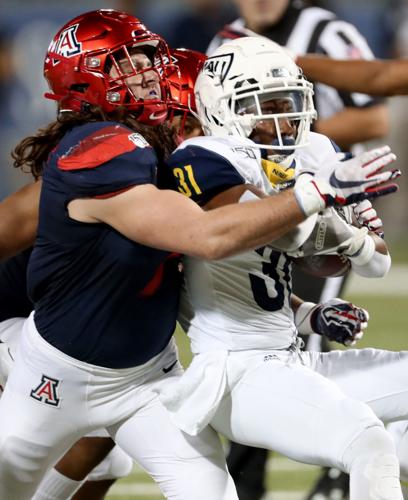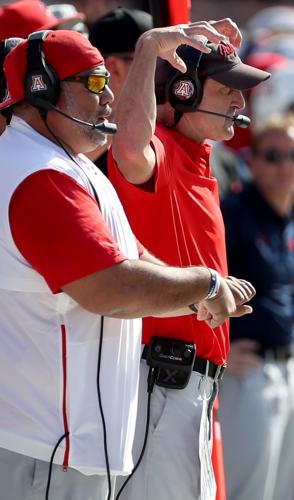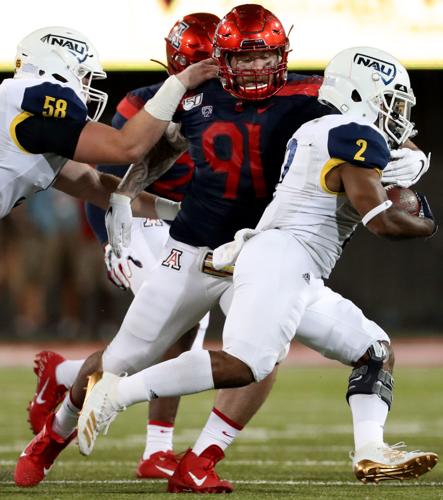Editor’s note: This is the third in a three-part series looking back at the 2019 Arizona Wildcats football season and ahead to next year. Today’s installment: Defense.
The Arizona Wildcats’ defense showed so little progress in 2019 that Kevin Sumlin fired three defensive aides during the season — an unprecedented move for a UA head coach.
They included defensive coordinator Marcel Yates, who was dismissed after a disappointing performance in a winnable game at Stanford on Oct. 26. Former Arizona All-American safety Chuck Cecil, at the time a senior staff analyst, took over on an interim basis for the final four games. Although the defense showed some promising signs down the stretch, Cecil is not expected to get the full-time job.
Once it was announced that Sumlin would return in 2020, the biggest question of the UA offseason became the identity of his next defensive coordinator.
We won’t attempt to answer that question here, because, at best, it would be an educated guess. But the qualities that coach and his staff must possess is among the topics we’ll explore in these three lingering questions about the Arizona defense:
1. Regardless of who it is, what are the traits the new DC needs to bring to the Arizona defense?

Chuck Cecil, right, was promoted to defensive coordinator in late October, replacing the fired Marcel Yates. He is not likely to return in the same capacity next season.
It’s unlikely that the new defensive coordinator will be able to pull off a dramatic, worst-to-first improvement, as we’ll illustrate in the next item. But a coaching change can and should make a difference if you bring in the right person.
As Sumlin and Dennis Polian — who’s essentially the football program’s general manager — go about narrowing their list and identifying their top candidate, there are two areas they should focus on: creativity and development.
The UA defense began to feel stale and static in Year 4 under Yates. Rarely did the Wildcats succeed in confusing opposing offensive lines or quarterbacks. The defense lacked movement and deception — two elements that can help offset gaps in talent.
Cecil made some subtle changes that helped. He regularly deployed a linebacker (sometimes two) at or near the line of scrimmage. That player, operating from a stand-up position, could rush or drop, causing uncertainty for the offense.
Under Cecil, Arizona also varied the splits of the defensive linemen. Finally, he blitzed defensive backs on occasion, something Yates seemed to do less and less. Opponents repeatedly blew up the UA offense with slot blitzes over the second half of the season.
You don’t want to overburden college players with overly complex schemes. One of the internal criticisms of Yates was that he sometimes would change the game plan during the week. But the Wildcats are capable of doing more than they’ve done, as Cecil demonstrated during his brief stint.
The other piece is player development. Five freshmen (including redshirt freshman Lorenzo Burns) started the majority of Arizona’s games in 2017. They were all on the team in ’19. Yet the defense backslid.
Aside from being able to communicate clearly and reinforce fundamentals, the new coordinator and/or other members of his staff need to have established track records coaching linebackers and edge rushers.
Arizona’s linebacker crew has not had a coach with a background in coaching linebackers since Scott Boone was let go in early 2018. Iona Uiagalelei, among the three coaches fired this season, handled the entire defensive line. The interior players showed improvement under Uiagalelei; the edge players did not.
The linebackers and edge rushers have more talent than recent results would suggest. They need the right coache(es) to help them unleash it.
2. Realistically, how much can the UA defense improve in one year?

Arizona defensive tackle Finton Connolly tries to wrap up NAU running back Nate Stinson during their September game. The Wildcats will replace defensive most of its defensive staff over the coming weeks.
The Wildcats rank last in the Pac-12 in points allowed and total defense entering bowl season. There’s only one way to go from there, right?
Assuming Arizona does get better next year, let’s take a look at what’s within the realm of possibility.
To do so, we charted points allowed and total defense for each of the other members of the Pac-12 before and after their most recent changes at defensive coordinator. (For Washington State, we used the hiring of Tracy Claeys in 2018, not his in-season resignation in ’19.)
In terms of points allowed, seven teams improved the following season.
The differential ranged from 1.5 points per game to 14.2.
Only three teams moved up in terms of their ranking in that category in the Pac-12: Cal in 2017, Arizona State in ’18 and Oregon this year. Those three also happened to experience the biggest drops in points allowed.
The Golden Bears surrendered the most points per game in the league in 2016 before the arrival of Tim DeRuyter as defensive coordinator. That number dropped from 42.6 to 28.4, and Cal’s league ranking jumped from 12th to seventh. It’s also important to note that Cal hired defensive-oriented Justin Wilcox as head coach at that time, replacing offensively inclined Sonny Dykes.
On average, Pac-12 teams improved by 2.66 points per game after their most recent moves at defensive coordinator (Oregon’s 2019 stats prior to Pac-12 Championship Game). The figures are somewhat skewed by Colorado, which got significantly worse defensively this year after changing coaching staffs.
In total defense, six of 11 teams improved after changing coordinators. The difference ranged from 33.6 yards per game to 88.3. Again, it was Cal in 2017 that experienced the biggest jump.
Two teams got worse by more than 60 yards: the aforementioned ’19 Buffaloes and Oregon State in ’18. In both cases, new head coaches came aboard and brought their own staffs – as opposed to coordinators being replaced because of poor performance.
The average improvement: 11.72 yards.
In terms of ranking within the Pac-12, the ’19 Ducks made the biggest jump, going from sixth to second. Cal improved from 10th in 2016 to seventh in ’17.
3. Who can Arizona build around in 2020?

Colin Schooler, left, may be someone UA can build around on defense during his senior season in 2020.
The obvious ones are the linebackers. Colin Schooler, Tony Fields II and Anthony Pandy finished 1-2-3 in tackles for the 2019 Wildcats. All are entering their senior seasons.
Burns and safety Scottie Young Jr. also are set to be seniors. Burns participated in this year’s Senior Night ceremony but is expected to return for a fifth season. Young struggled early in the season at free safety before looking more comfortable at boundary safety. Where he’ll fit best in the new scheme remains to be seen.
A handful of 2019 newcomers look like potential foundational pieces. Defensive tackle Trevon Mason, a junior-college transfer, started 11 games and had 44 tackles, including six for losses.
He also spoke at the end of the year about becoming a more vocal leader.
Freshman Christian Roland-Wallace started eight games at cornerback. He struggled at times but ended up third on the team with five pass breakups. Pro Football Focus gave him an honorable-mention nod on its Freshman All-America Team.
At least three other ’19 newcomers — defensive tackles Kyon Barrs and Myles Tapusoa and cornerback Bobby Wolfe — should play sizable roles next season.
Finally, Arizona is set to bring back three veteran defensive ends in JB Brown, Jalen Harris and Kylan Wilborn.
All have flashed all-conference ability at one time or another. Will they finally do it consistently under new leadership?






